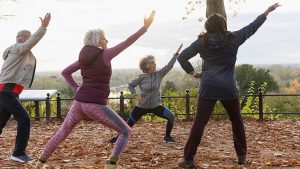Improve Diabetes in Older and Elderly Patients with Tai Chi
By John M. de Castro, Ph.D.
“Tai Chi exercises can improve blood glucose levels and improve the control of type 2 diabetes and immune system response.” – Medical News Today
Diabetes is a major health issue. It is estimated that 30 million people in the United States have diabetes and the numbers are growing. Type 2 Diabetes results from a resistance of tissues, especially fat tissues, to the ability of insulin to promote the uptake of glucose from the blood. As a result, blood sugar levels rise producing hyperglycemia. Diabetes is the 7th leading cause of death in the United States. In addition, diabetes is heavily associated with other diseases such as cardiovascular disease, heart attacks, stroke, blindness, kidney disease, and circulatory problems leading to amputations. As a result, diabetes doubles the risk of death of any cause compared to individuals of the same age without diabetes.
Type 2 diabetes is largely preventable. One of the reasons for the increasing incidence of Type 2 Diabetes is its association with overweight and obesity which is becoming epidemic in the industrialized world. A leading cause of this is a sedentary lifestyle. Current treatments for Type 2 Diabetes focus on diet, exercise, and weight control. Recently, mindfulness practices have been shown to be helpful in managing diabetes. Tai Chi is mindfulness practice and a gentle exercise that has been found to improve the symptoms of Type 2 Diabetes. The research is accumulating. So, it is reasonable to examine what has been learned.
In today’s Research News article “A Meta-Analysis of the Effects of Tai Chi on Glucose and Lipid Metabolism in Middle-Aged and Elderly Diabetic Patients: Evidence from Randomized Controlled Trials.” (See summary below or view the full text of the study at: https://www.ncbi.nlm.nih.gov/pmc/articles/PMC8007338/ ) Liu and colleagues review, summarize, and perform a meta-analysis of the published randomized controlled studies of the effectiveness of Tai Chi practice in the treatment of Type 2 Diabetes in older and elderly patients. They identified 14 published studies.
They report that the published studies found that Tai Chi practice produced significant reductions in fasting blood glucose levels, glycated hemoglobin, cholesterol, triglycerides, and low density lipoproteins, and significantly increased the levels of high density lipoproteins. They report that these improvements occurred predominantly in studies where Tai Chi was practiced for at least 50 minutes per day, for at least 12 weeks.
The findings of this meta-analysis suggests that Tai Chi practice is a safe and effective treatment for older and elderly patients with Type 2 Diabetes improving blood glucose and lipid profiles. It is important to note that Tai Chi practice is gentle and completely safe, can be used with the elderly and sickly, is inexpensive to administer, can be performed in groups or alone, at home or in a facility or even public park, and can be quickly learned. In addition, it can also be practiced in social groups without professional supervision. This can make it fun, improving the likelihood of long-term engagement in the practice. Hence, Tai Chi practice is an almost ideal treatment for Type 2 Diabetes
So, improve diabetes in older and elderly patients with Tai Chi.
”Stress stands in the way of controlling diabetes. Since tai chi encourages mental relaxation and reduces stress, it follows that Tai Chi can improve the control of diabetes.” – Paul Lam
CMCS – Center for Mindfulness and Contemplative Studies
This and other Contemplative Studies posts are also available on Google+ https://plus.google.com/106784388191201299496/posts and on Twitter @MindfulResearch
Study Summary
Liu, Y. N., Wang, L., Fan, X., Liu, S., Wu, Q., & Qian, Y. L. (2021). A Meta-Analysis of the Effects of Tai Chi on Glucose and Lipid Metabolism in Middle-Aged and Elderly Diabetic Patients: Evidence from Randomized Controlled Trials. Evidence-based complementary and alternative medicine : eCAM, 2021, 6699935. https://doi.org/10.1155/2021/6699935
Abstract
This research review aimed to evaluate the effect of practicing Tai Chi on glucose and lipid metabolism in middle-aged and elderly diabetic patients. Furthermore, it aimed to provide a theoretical basis for the practice of Tai Chi as a way to improve glucose and lipid metabolism in middle-aged and elderly diabetic patients. Therefore, we searched for randomized controlled trials on the practice of Tai Chi in middle-aged and elderly diabetic patients in Chinese- and English-language electronic databases, such as Web of Science, PubMed, the Cochrane Library, EMBASE, Google Scholar, CNKI, Wanfang Database, and Weipu. We collected articles published no later than August 1, 2020. The methodological quality of the included studies was evaluated according to the standards of the Cochrane Collaboration System Evaluation Manual (version 5.1.0). Finally, 14 articles were included, showing an average Physiotherapy Evidence Database scale score of 6.57. The articles were meta-analyzed using Stata 14.0 software, showing that practicing Tai Chi improved middle-aged and elderly diabetic patients’ fasting blood glucose (WMD = −0.60, 95% CI [−1.08, −0.12], p=0.015), glycosylated hemoglobin (WMD = −0.87, 95% CI [−1.60, −0.14], p=0.019), total cholesterol (WMD = −0.48, 95% CI [−0.83, −0.14], p=0.006), triglycerides (WMD = −0.21, 95% CI [−0.37, −0.04], p=0.014), and low-density lipoprotein cholesterol level significantly (WMD = −0.32, 95% CI [−0.63,−0.00], p=0.050). Conversely, patients’ high-density lipoprotein cholesterol levels (WMD = 0.09, 95% CI [−0.01, 0.17], p=0.136) showed no obvious improvement. In conclusion, practicing Tai Chi in sessions lasting longer than 50 minutes (at least three times per week, for at least 12 weeks) can effectively improve glucose and lipid metabolism in middle-aged and elderly diabetic patients. However, several other factors affect glucose and lipid metabolism; therefore, further high-quality research is needed.
https://www.ncbi.nlm.nih.gov/pmc/articles/PMC8007338/
